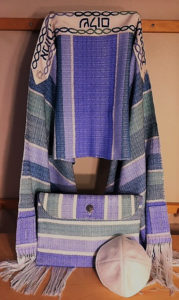Tallit
About Tallit
 Tallit, or prayer shawl, in Hebrew means little tent because it is worn over your body like a little tent as in…Psalms 61:4 “Let me dwell in your tent forever! Let me take refuge under the shelter of your wings!” The idea is that by surrounding yourself you shut out the world and are better able to concentrate on prayer. In Greek the word for tallit means “closet,” an inner chamber, or a secret room. By closeting yourself in the covering of this rectangular garment you are separating yourself from the world around you.
Tallit, or prayer shawl, in Hebrew means little tent because it is worn over your body like a little tent as in…Psalms 61:4 “Let me dwell in your tent forever! Let me take refuge under the shelter of your wings!” The idea is that by surrounding yourself you shut out the world and are better able to concentrate on prayer. In Greek the word for tallit means “closet,” an inner chamber, or a secret room. By closeting yourself in the covering of this rectangular garment you are separating yourself from the world around you.
Traditionally tallitot (plural) were worn only by men and were usually woven of wool with white background and horizontal stripes of black and gray or dark and light blue. Today, men and women both wear tallitot woven with traditional or contemporary designs. I can weave them in any size, from a narrow width of 16-18” to the more customary width of about 20”-25″.
About Atarah
In Hebrew atarah means crown and is woven into or sewn onto the tallit as if it were a collar. It can be made of the same cloth as the tallit or of a contrasting color and texture. The atarah can be embroidered with Judaic symbols or Hebrew letters.
About Tzitzit
The strings tied in the four corners of the tallit are known as tzitzit and are called for in Numbers 15:38: “Speak to the Children of Israel, and say to them, that they shall make themselves tassels on the corners of their garments throughout their generations…” Wearing the tzitzit is also commanded in Deuteronomy 22:12: “You shall make yourself twisted cords, on the four corners of your garment with which you cover yourself.” The purpose of wearing tzitzit is to remind Jews of their religious obligations. In addition, it serves as a reminder of the exodus from Egypt.
Some of my clients order their tallit with tzitzit and some do not. Likewise, some ask me to tie them according to Torah instructions and some prefer to tie them with their rabbi. The choice is personal preference.
About Tallitot Bags
Today, most Jews have a bag in which to store their tallit—to keep it clean and safe. I sew the bags from the same woven cloth as the tallit with either a flap or zipper for the closing.
About Kippah
The term kippah literally means “dome,” and whoever wears this dome is acknowledging the constant divine presence that covers them. The Yiddish term yarmulke is often associated with an Aramaic phrase meaning “in awe of the king.” Some Jews wear the kippah at all times; some only when they pray.
Other than Orthodox Jews who wear the Jewish hat, a broad trimmed black hat with tall crown, today most Jews wear either the skull cap or the pill box type.
